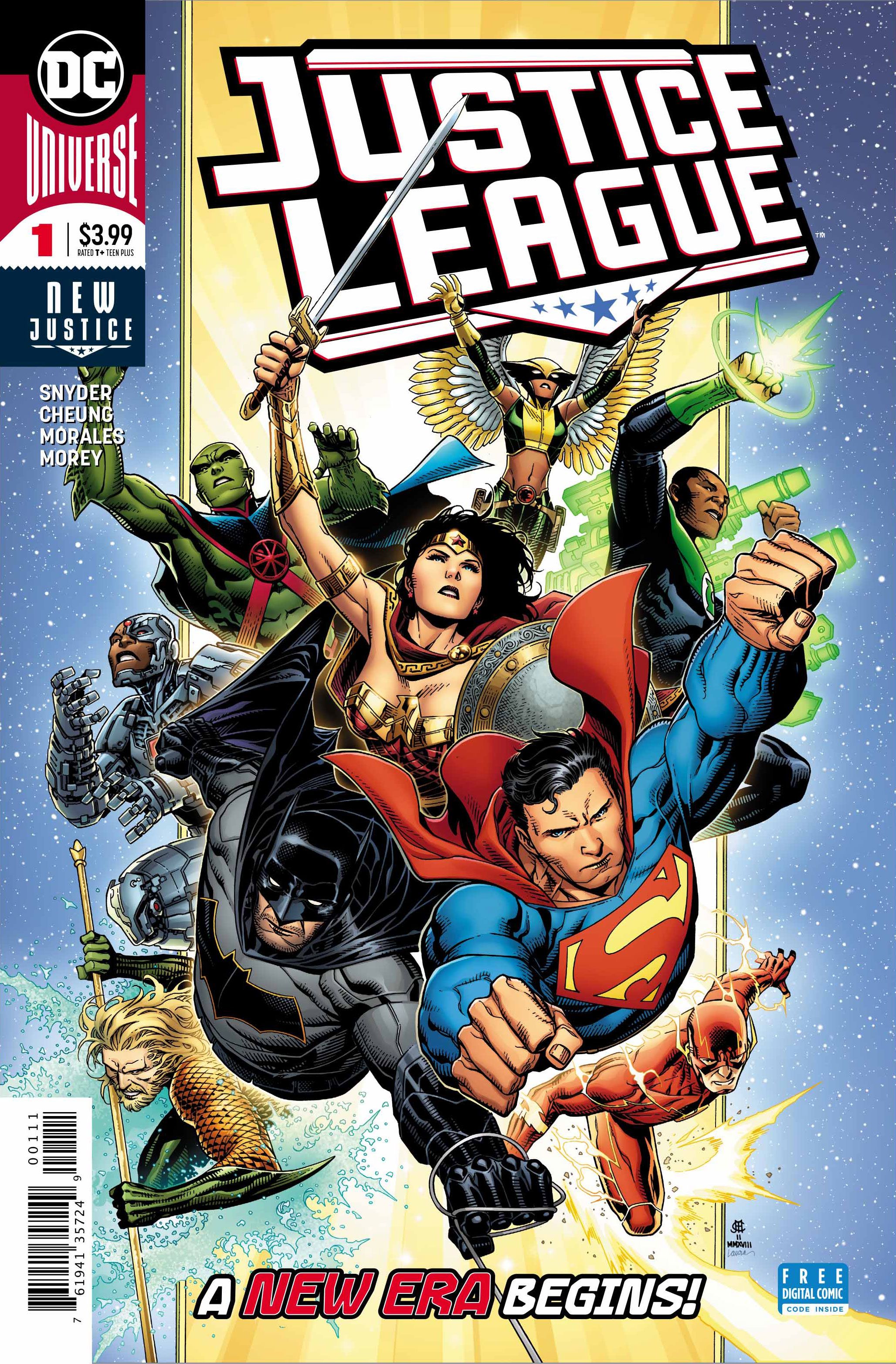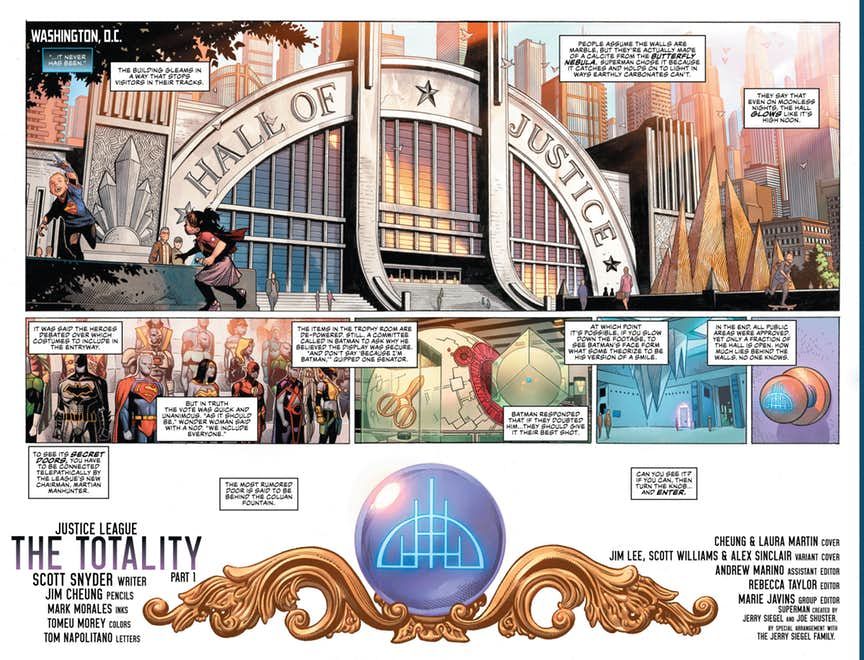Justice League #1
- WRITER
- Scott Snyder
- Artist
- Mark Morales, Jim Cheung
- Letterer
- Tom Napolitano
- Cover Artist
- Laura Martin, Jim Cheung
- Publisher
- DC Comics
- Price
- 3.99
- Release Date
- 2018-06-06
- Colorist
- Tomeu Morey
The greatest heroes of the DC Universe banding together and protecting the world from the most awesome of threats is as old as the concept of the DC Universe itself. It dates back to the Justice Society of America, which brought popular heroes like Green Lantern, The Flash and Hawkman together. Two decades later, the Justice League of America updated the format for a new age and -- if the apocryphal tale is to be believed -- inspired the creation of the Fantastic Four, which saw the birth of the Marvel Universe. Now, Scott Snyder and a murderer’s row of some of the top creators at DC -- both writers and artists -- seek to capture that magic again with a brand new Justice League #1, which kicks off a new era of "New Justice."
Justice League #1 is going to draw comparisons to a similar relaunch in the mid-90s, when Grant Morrison and Howard Porter brought together the “Big Seven” for JLA, which featured some of the most accessible stories of Morrison’s superhero ouvre and some of the most popular and fondly remembered stories of the 1990s; an era not remembered too fondly. Justice League #1 is a similarly back-to-basics approach for the team, inspired by the mid-2000s Justice League cartoon as it is Morrison and Porter’s JLA -- but that doesn’t mean it’s a retread. It’s an ode to the DC Universe and its greatest heroes; the characters feel like friends again as they make jokes about Batman’s voice while fighting “Neoanderthals," the incoming threat of “The Totality” is something new brought into the universe by the events of Dark Nights: Metal and Lex Luthor’s return to villainy isn’t anywhere near as simple as it might seem.
RELATED: Lex Luthor Now Holds the Key to the Mysteries of the DC Universe – Literally
If the new Justice League has any one stand-out star, it’s Martian Manhunter; a long-time fan-favorite often referred to as the heart of the Justice League. It’s been a long time since J’onn J'onzz has been that heart but Snyder gives extra care and attention to his role as the nucleus which binds the rest of the team together. Flashbacks to his tragic past on Mars, prophecies of tragedies yet to come and a focus on an inner struggle all spotlight why people love the Manhunter From Mars, proving that genuine character work can still be accomplished in a team book with as large a scope as Justice League.
Scott Snyder opts for a more timeless narration in Justice League #1, and the third person perspective is essential for achieving one of the title’s primary objectives: to raise the heroes of the DC Universe back to larger-than-life status. It’s something that’s been missing since the New 52 relaunch and a key feature of DC’s superhero universe that the Rebirth initiative sought to bring back. While likely meant to evoke Bronze Age comics, the narration in the double-page intro is more reminiscent of Neil Gaiman’s prose in Sandman. “Can you see it? If you can, then turn the knob… and enter” asks the nameless, omniscient narrator, inviting the reader into a world of gods and monsters; of Justice and of Doom.
Jim Cheung has been a staple of Marvel Comics for decades now, and was one of the publisher’s go-to artists to signify “this is an important comic.” His work on Young Avengers rocketed him to superstardom and though not the primary artist more often than not, his contributions to mega-events such as Avengers vs X-Men, Infinity and Civil War II carried the semiotic weight necessary to establish the tone. Cheung brings that same gravitas to Justice League #1, aided by long-time collaborator Mark Morales but colored by Tomeu Morey, who has worked almost exclusively for DC Comics throughout his career.
Morey’s palette helps ground Cheung’s art in the familiar of the DC Universe and eases the transition as one of Marvel’s biggest names finds his feet at the publisher. By the time you’re through the “all-hands-on-deck” first act of Justice League #1, it feels like Cheung and Morales have been working in the DC Universe forever, and this is where they belong. To return to an earlier point, Justice League excels at making these heroes feel larger than life once again and Cheung is undoubtedly one of the greatest superhero artists of his generation. A lot of the previous criticisms leveled at him -- his Steve Rogers looks like his Clint Barton looks like his Johnny Storm -- don’t apply to the Justice League, and he delivers some of his career best work in this debut issue.
If you ever thought that a letterer’s role in the comic making process wasn’t vital, you’re wrong and Justice League #1 will change your mind. Tom Napolitano bring so much flavor and character to this title that it’s a shame he isn’t credited on the cover with the rest of the creative team. Small touches, like colored rings around speech balloons to indicate which character is talking telepathically or the different fonts used when characters mock Batman by imitating his gravelly growl, help bring the characters to life and reinforce the three-dimensional portrayals Snyder and Cheung are crafting.
RELATED: Justice League Hints At The Death & Return Of The Justice Society of America
Justice League #1 is a must-read for fans of superheroics as a genre and reminds you that while you can do subversive and edgy stuff within the confines of a superhero universe, a straight-up superhero story of good vs. evil can still be as gripping and essential as it was in 1940. As a debut issue, it’s hugely rewarding and feels denser than its 22 pages. As the start of a new era, it’s hugely promising for the future of the DC Universe and the expanded Justice League line under Scott Snyder’s stewardship.


